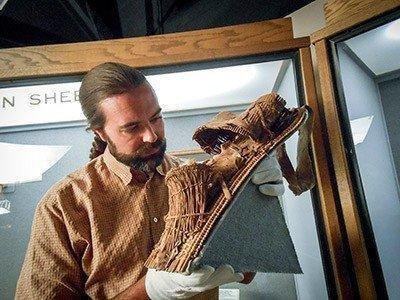Archaeologist Tim Riley holding a one-of-a-kind Fremont figurine-cradleboard.
Press Release
PRICE, Utah — A valuable collection of ancient Fremont Indian craftsmanship, including a one-of-a-kind unfired clay figurine in a miniature cradleboard, has been donated to the Utah State University Eastern Prehistoric Museum in Price.
What started as a loan in 2004 is now a permanent gift to the museum from the descendants of the late Ephraim P. and Dorothy Hickman Pectol family, formerly from Torrey, Utah. They gave the collection to the museum to ensure the preservation of their scientifically valuable archaeological finds for future generations in a public museum, said Kenneth Carpenter, museum director and curator of paleontology.
This assemblage of Fremont artistry is one of the best private collections in the state from the early 20th century. The miniature cradleboard, made from willow, rabbitbrush and animal fur, is a rare example of Fremont Indian artisanship, Carpenter said.
Clay figurines are common at Fremont sites and believed to have had religious significance.
“This is the first example where the figurine is tied to an object that we generally associate with carrying babies,” Carpenter said. “This figurine-cradleboard combination may have had religious significance associated with a baby, such as the death of a child, or hope for the future generation, or even a fertility charm. The actual purpose remains unknown.”
What archaeologists do know is that this collection is from the Fremont River drainage — the very location that defined the Fremont Culture in 1931 when Ephraim Pectol guided Harvard Archaeologist Noel Morss to sites along the Fremont River, Carpenter said.
“It is a priceless collection that includes many rare items from the everyday life of the Fremont people, such as homemade string and a ladle made from the horn of a bighorn sheep,” he said. “It also has a deer antler with a hole in it. This handy tool was used to straighten the shaft of arrows to make them fly straight and true.”
Ephraim and Dorothy originally displayed these ancient strings and ladles and other domestic items alongside the hardware and homeware they once sold in their Torrey General Store. It was during the Great Depression and a time when Ephraim spent many long hours scouring the canyons of what would eventually become Capitol Reef National Park, a designation he championed early on.
His General Store collection, and many more artifacts, eventually was put on display at Capitol Reef, then Temple Square, and then at the Museum of Peoples and Culture at Brigham Young University in the late 1990s.
The collection preserves some of the few examples of painted and woven decorated Fremont baskets known today, according to USU Eastern Prehistoric Museum Archaeologist Tim Riley. That is what makes this acquisition so significant. It is the largest collection of what archaeologists call perishables — the baskets and leather items of the Fremont people. “In most archaeological sites, these types of objects have decayed away,” he said.
Among these newly acquired artifacts is a significant collection of material from the frontier between the Kayenta Anasazi — ancient Puebloan people from southeastern Utah and Arizona — and the Fremont people.
“They traded ideas and goods, lived in the same communities and even intermarried,” Riley said.


